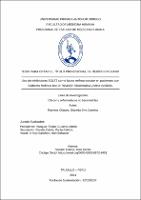Uso de inhibidores SGLT2 como factor nefroprotector en pacientes con Diabetes Mellitus tipo 2: Revisión Sistemática y Meta-Análisis.

Fecha
2024Autor(es)
Ramírez Chávez, Gianella Elva Carolina
Metadatos
Mostrar el registro completo del ítemResumen
Evaluar si el uso de inhibidores SGLT2 es factor nefroprotector en
pacientes adultos con Diabetes Mellitus tipo 2.
Material y métodos: Este estudio de revisión sistemática y metaanálisis, siguió
las directrices PRISMA 2020. Se realizó búsqueda estratégica en cuatro bases
de datos: Pudmed, Web of Science, Scopus y Embase. Se incorporaron ensayos
clínicos aleatorizados, los artículos fueron almacenados y seleccionados en el
software Rayyan: posteriormente la extracción de datos se realizó en Microsoft
Excel 2019. El riesgo de sesgo se analizó con la herramienta RoB 2.0 de la
Colaboración Cochrane. El meta-análisis mediante el software libre RStudio; la
evaluación de la calidad y la certeza de evidencia se realizó en el programa
GRADEpro.
Resultados: Se incluyeron 12 ensayos clínicos aleatorizados en el meta
análisis. A las 12 semanas no se encontró diferencia significativa respecto a la
media en la tasa de filtración glomerular (TFG) en el grupo intervención
comparado con placebo (MD: 0.78; IC 95%: -1.36 a 2.92; I2=0%; p=0.43) Sin
embargo, los inhibidores SGLT2 redujeron significativamente la pérdida
progresiva de la TFG a los 2 años (RR: 0.66; IC 95%: 0.49 a 0.89; p<0.001) de
igual manera a los 3, 4 y 7 años.
Conclusión: Los inhibidores SGLT2 disminuyeron significativamente la pérdida
progresiva de la TFG frente a placebo, a mayor tiempo de duración del
tratamiento. Asimismo, la presión arterial sistólica y diastólica tuvo efecto
beneficioso reduciendo así el riesgo cardiovascular; también redujo el porcentaje
de HbA1c y peso corporal To evaluate whether the use of SGLT2 inhibitors is a nephroprotective
factor in adult patients with type 2 diabetes mellitus.
Methods: This systematic review and meta-analysis study followed the PRISMA
2020 guidelines. A strategic search was performed in four databases: Pudmed,
Web of Science, Scopus and Embase. Randomized clinical trials were
incorporated, articles were stored and selected in Rayyan software: subsequently
data extraction was performed in Microsoft Excel 2019. Risk of bias was analyzed
using the RoB 2.0 tool of the Cochrane Collaboration. Meta-analysis was
performed using the free software RStudio; the evaluation of the quality and
certainty of evidence was performed in the GRADEpro program.
Results: Twelve randomized clinical trials were included in the meta-analysis. At
12 weeks, no significant difference was found with respect to mean glomerular
filtration rate (GFR) in the intervention group compared to placebo (MD: 0.78;
95% CI: -1.36 to 2.92; I2=0%; p=0.43) However, SGLT2 inhibitors significantly
reduced the progressive loss of GFR at 2 years (RR: 0.66; 95% CI: 0.49 to 0.89;
p<0.001) as well at 3, 4 and 7 years.
Conclusion: SGLT2 inhibitors significantly decreased the progressive loss of
GFR compared to placebo, with longer treatment duration. Likewise, systolic and
diastolic blood pressure had a beneficial effect, thus reducing cardiovascular risk;
it also reduced the percentage of HbA1c and body weight.
Palabras clave
Colecciones
- Medicina Humana [2969]

